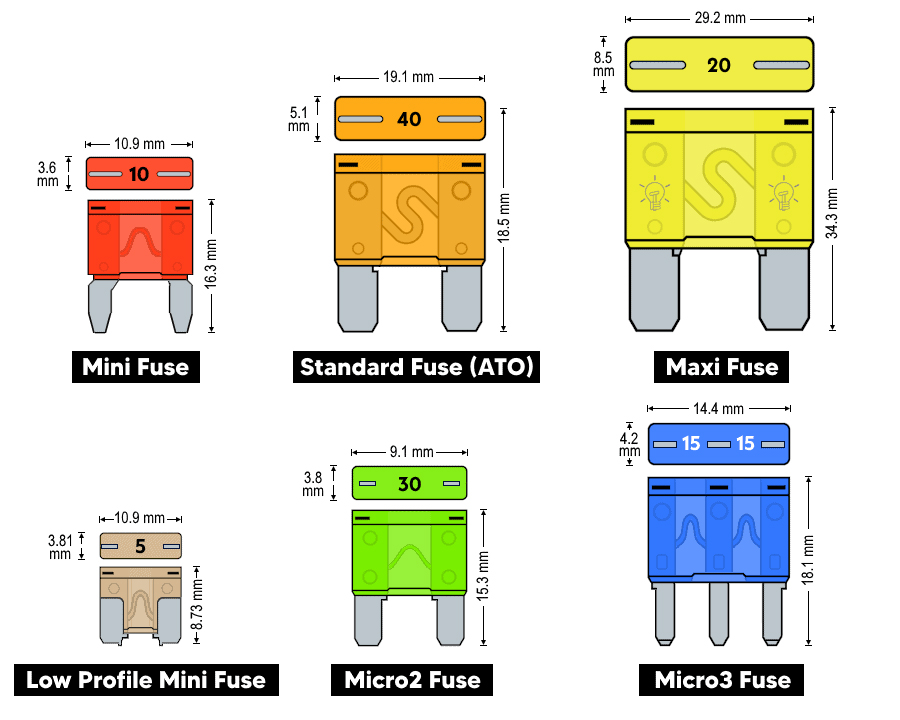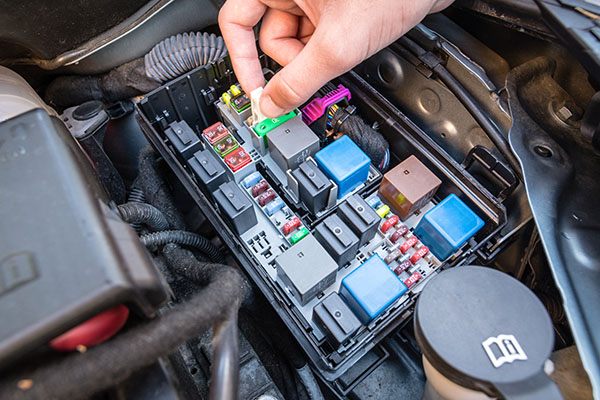The Ultimate Guide to Car Fuses: How to Identify, Replace, and Prevent Electrical Failures
Author:admin Date: 2025-08-06 03:21 Views:122
- परिचय
- Importance of Car Fuses
- Types of Car Fuses
- Why Car Fuses Blow
- How to Locate Your Car’s Fuse Box
- How To Tell If A Car Fuse Is Blown
- How To Check Car Fuses With A Multimeter
- Choosing the Right Replacement Fuse
- How To Replace A Fuse In A Car
- When to Call a Mechanic
- Preventing Fuse Issues in the Future
- निष्कर्ष
परिचय
Most people know fuses from their electronics at home or in the office. Well, a car also has fuses. These car fuses still serve the same purpose as the other types of fuses in electronics.
Car fuses are important safety devices that protect a vehicle’s electrical circuits from damage caused by excessive current flow. The fuses act as the weakest point in the circuit, easily breaking or melting to interrupt the current flow if the current is too high compared to the rated amount.
Importance of Car Fuses
As we have already seen, a car fuse is important to protect the electrical components. They act as the weakest point of the circuit and break it if there is excessive current in the circuit. This excessive current should not reach the sensitive components, as it can damage them.
The other reason for fuses in a car is to help prevent fires. Since the flow of excessive current has been interrupted, overheating and potentially igniting of the surrounding materials is prevented.
The fuses in the car fuse box also ensure proper functioning of the electrical components. This includes the headlights, turn signals, ECU, and radio. If a fuse is blown, then the corresponding device will not work. This shows there is an issue with the circuit.
Types of Car Fuses

There are multiple car fuse types but they are mostly categorized as blade fuses and glass tube fuses.
The blade fuses are the most common and it is hard to miss them because of their design. The blade fuses have two prongs on either side shaped as a blade. The two blades are connected with thin wire that is rated depending on the expected current it will be carrying.
Under the blade uses, you have options such as ATO/ATC fuses, Mini and Low-Profile mini fuses, Micro2 and Micro3 fuses, and Maxi fuses. Each fuse type has a current rating written on it. Keep it in mind as it determines how best to use it.
You can also get glass tube car fuses as well. These are cylindrical-shaped fuses with metal ends and a transparent glass wall. They are not common in modern vehicles, but you may come across them in older models.
Why Car Fuses Blow
ए car fuse tester is a good tool to help tell if a fuse is blown. However, before we get there, we need to understand why car fuses blow in the first place. Here are some reasons.
1. Short Circuits
A short circuit can happen when the insulation wears away, allowing the current to touch the metal part of the vehicle or another wire with a different electrical load. This creates a direct path for the current rather than the intended circuit, causing a surge in the current that blows the fuse.
Other reasons for shorts include corrosion, damaged wiring, and loose connections.
2. Overloaded circuits
An overloaded circuit occurs when too many electrical components draw a lot of power from a single circuit. The result is that the electrical current exceeds the circuit’s capacity.
Overloaded circuits mean a high current passes through the fuse, which now blows.
Take the example of using a high-power stereo system that draws a lot of current. This will definitely cause the fuse to flow.
Overloaded circuits can also be as a result of defective components that draw excessive currents that you do not expect.
3. Incorrect fuse size
Think of a scenario where you are using a higher amperage rating fuse for a circuit that should be operating at a lower current rating. This means the fuse will allow more current to flow than the wiring is allowed to handle. The result is fire or other damage.
Using a fuse with a lower amperage rating than the recommended size means it will blow prematurely even when the circuit is running with a normal load.
As you can see, it is vital to always use the correct rating for the circuit to function properly.
How to Locate Your Car’s Fuse Box

Let us assume you have a blown car fuse and you would like to change it. Then, locating the fuse box of a car is important.
The location of the fuse box varies from one car to another, but some locations are common for various models. One way to be sure about the location of the fuse box is to check the owner’s manual. This is a reliable way of easily pinpointing the exact location of the fuse boxes.
However, what if you do not have a manual for that specific car? One location to get the fuse box would be the engine compartment. In this case, the fuse box would be near the battery and covered. It is hard to miss because it will have the term “fuse box” written on it or fuses drawn on the cover.
Look under the dashboard, mostly on the driver’s side under the steering column. Depending on the vehicle, you are likely to find a fuse box there with additional fuse models.
How To Tell If A Car Fuse Is Blown

One of the signs would be that the electrical components do not work. For example, your power windows and locks suddenly stop working. Start by looking for a blown fuse, which could be why it stopped working.
It is the same thing when your lights or radio stop working. Look at their respective fuses to identify if there is an issue.
You may also smell something burning in the fuse box. Other than that, you may also get a dashboard warning light indicating something is wrong with the fuses.
It is also essential to consider a visual inspection of the fuse. This includes checking for a broken filament, which will clearly indicate that the fuse is blown and needs replacement.
Besides the broken filament, the fuse can melt or blacken, showing it is burned, possibly due to a high current.
How To Check Car Fuses With A Multimeter
Other than a car fuse tester light, you could use a multimeter to identify blown car fuses and start the process of replacing them. We will be testing for continuity in this case. Here is the process for testing with a multimeter.
- Turn off the vehicle and ensure the battery is disconnected
- Locate the fuse box and single out the fuse you would like to test
- Set the multimeter to the continuity setting
- Test the fuse while it is still in the fuse box. Touch either side with the leads to measure continuity.
- For a good fuse, there is a beep or low resistance.
- A blown fuse does not beep, and a high resistance reading will occur. This indicates a blown fuse that needs replacement.
Choosing the Right Replacement Fuse
Now that you have identified that there is a problem with the fuse, the next step is to find a suitable replacement. Here is how to choose the right replacement fuse.
- Identify the correct amperage rating. This information is written on the fuse box. This ensures that you get exactly what works with the car’s electrical circuit. For example, some will be written 10amps, others more or less. So, when you are buying a new fuse, request the exact amperage rating.
- Consider the fuse’s speed. Yes, this is how fast the fuse can react to cut off the excess current. The manufacturer will indicate this so that you can choose appropriately.
- Physical size is also important. Luckily, most sizes are standardized, so fitting into each other should not be a problem. You can always take the blown fuse to the shop and use it to find the correct size.
- It is highly recommended that you buy from reputable brands. This ensures that you always get high-quality fuses that will not blow unexpectedly the next time you drive the vehicle.
How To Replace A Fuse In A Car
Replacing a fuse in a car should not take long. If you have like two minutes to spare, you should be good.
Start by locating a fuse box by using your owner’s manual or check around the battery area or under the steering column on the dashboard.
Open the fuse box to identify the blown fuse. It should be easy to find one that is blown by checking the corresponding device that is not working. The fuse box cover usually indicates which fuse belongs to which circuit.
Remove the blown fuse with a car fuse puller. You could still use needle-nose pliers. Such a tool is important so that you can remove the blown fuse without damaging the other surrounding fuses.
Install a new fuse with the correct amperage in its place. Insert the fuse gently into the corresponding slot and push it down until it is firmly seated.
Test the circuit by reconnecting the battery and turning on the vehicle.
When to Call a Mechanic
By now, you know if a car fuse is blown and how to remove a fuse from a car. So, when do you think it would be appropriate to call a mechanic for help?
When you repeatedly have blown fuses. This means that there is more to it. There are definitely more underlying electrical issues such as short circuits or faulty wiring.
A burning small or damaged fuse box can be a sign of more serious electrical problems that need a professional to look at.
Sometimes you are just unsure of what you are doing. It is okay to have someone with the knowledge to help with troubleshooting and replacing any blown fuses.
Preventing Fuse Issues in the Future
Sometimes you can prevent busted car fuses from happening with preventative measures. For example, you should identify and address circuit overloads. Try to avoid overloading the circuits with too many devices.
Regular inspections of the fuse box can help watch out for signs of wear, corrosion, or damage. These could potentially lead to short circuits, which now blow the fuse.
Protect the fuse box from moisture. We all know how water and electricity do not mix well. For this reason, you should keep the moisture from building up, as it can also lead to corrosion.
Always use the correct amperage fuses as this ensures the circuits operate at the recommended current rating. The last thing you need is using a fuse with a low or too high amperage rating than the recommended value.
निष्कर्ष
Car fuses remain important for the electrical circuits in a vehicle. It is why you should always make sure your fuses are in good condition and replace the blown ones. If you are going to replace a blown fuse, make sure you are using the right one with the correct amperage rating. Also, buy from a top brand with the assurance it will be a good fuse for the job.
कृपया आरएफक्यू भेजें, हम तुरंत जवाब देंगे।
अक्सर पूछे जाने वाले प्रश्नों
Can I replace a blown car fuse by myself?
Yes. Replacing a fuse is usually simple, and anyone can do it. Just make sure the car is turned off first. Locate the blown fuse and replace it with a new fuse with the same amperage rating.
Are car fuses universal?
No. Different types of car fuses are available on the market. It is, therefore, important to replace it with the correct type. Other than the type, the amperage rating should be the same as the one you are replacing or as recommended on the fuse box.
What is the price of a car fuse?
Car fuses are mostly inexpensive. They are usually under $5. However, you can get assorted fuse kits for up to $20. If you have to hire a mechanic to do the job, the labor costs will vary from $50 to $100, depending on the necessary diagnosis to get the vehicle working again.


